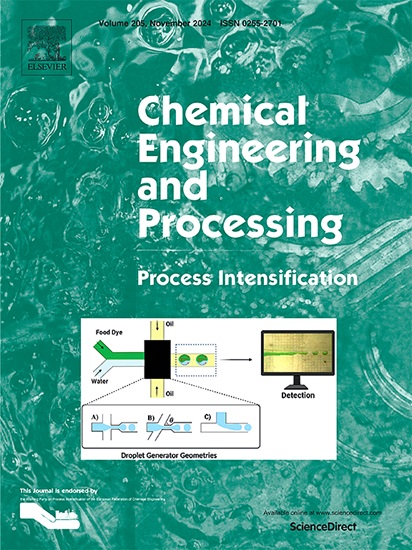Study on internal circulation patterns and heat transfer characteristics of gas-liquid Taylor flow in a gradually expanding microchannel
IF 3.8
3区 工程技术
Q3 ENERGY & FUELS
Chemical Engineering and Processing - Process Intensification
Pub Date : 2025-03-20
DOI:10.1016/j.cep.2025.110283
引用次数: 0
Abstract
The internal circulation within the gas-liquid Taylor flow slug promotes radial fluid mixing, which is a key factor in enhancing heat and mass transfer rates. The present study investigates numerically the internal circulation patterns of gas-liquid Taylor flow slugs in a gradually expanding microchannel and their effect on heat transfer characteristics. The flow field structure and heat transfer performance of slugs in straight and gradually expanding channels under different flow velocity conditions are compared and analyzed. The results show that secondary vortices within the slug significantly enhance the mixing in the liquid phase, thus improving local heat transfer efficiency. In the expanding channel, the gradual increase in hydraulic diameter promotes the formation and development of secondary vortices, leading to the further intensification of heat transfer. Under these conditions, the secondary circulation zone significantly impacts the main circulation zone, and its contribution to strengthening heat transfer cannot be ignored. This study provides a theoretical basis for optimizing the design of microchannel heat sinks with broad engineering applications, particularly in device cooling and efficient heat dissipation.
逐渐膨胀微通道中气液泰勒流内循环模式及换热特性研究
气液泰勒流段塞内的内部循环促进了径向流体混合,这是提高传热传质率的关键因素。本文用数值方法研究了气液泰勒流段塞在逐渐膨胀的微通道中的内循环模式及其对传热特性的影响。对比分析了不同流速条件下直流段和渐扩通道段塞的流场结构和换热性能。结果表明,段塞内的二次涡显著增强了液相的混合,从而提高了局部换热效率。在膨胀通道中,水力直径的逐渐增大促进了二次涡的形成和发展,导致换热进一步加剧。在此条件下,二次环流区对主环流区影响显著,对强化换热的贡献不容忽视。该研究为微通道散热器的优化设计提供了理论基础,具有广泛的工程应用,特别是在器件冷却和高效散热方面。
本文章由计算机程序翻译,如有差异,请以英文原文为准。
求助全文
约1分钟内获得全文
求助全文
来源期刊
CiteScore
7.80
自引率
9.30%
发文量
408
审稿时长
49 days
期刊介绍:
Chemical Engineering and Processing: Process Intensification is intended for practicing researchers in industry and academia, working in the field of Process Engineering and related to the subject of Process Intensification.Articles published in the Journal demonstrate how novel discoveries, developments and theories in the field of Process Engineering and in particular Process Intensification may be used for analysis and design of innovative equipment and processing methods with substantially improved sustainability, efficiency and environmental performance.

 求助内容:
求助内容: 应助结果提醒方式:
应助结果提醒方式:


